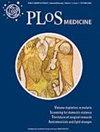谷氨酸输注对高危患者冠状动脉搭桥术后NT-proBNP的影响(GLUTAMICS II):一项随机对照试验
IF 9.9
1区 医学
Q1 MEDICINE, GENERAL & INTERNAL
引用次数: 3
摘要
背景动物和人体资料表明,谷氨酸能促进缺血后心肌代谢和功能的恢复。N-末端脑钠肽原(NT-proBNP)反映冠状动脉搭桥术(CABG)后的心肌功能障碍。我们研究了谷氨酸盐输注是否能降低冠状动脉旁路移植术后中高危患者NT-proBNP的升高。方法和发现一项前瞻性、随机、双盲研究纳入了2015年11月15日至2020年9月30日的患者,在瑞典的4个学术心脏外科中心进行了为期30天的随访。患者接受CABG±瓣膜手术,左心室射血分数≤0.30或EuroSCORE II≥3.0。在释放主动脉交叉夹之前10至20分钟开始以1.65 mL/kg/h的速度静脉输注0.125 M L-谷氨酸或生理盐水,然后再持续150分钟。患者、工作人员和研究人员对这种治疗方法视而不见。主要终点是术前和术后第3天NT-proBNP水平之间的差异。分析是有意治疗。我们研究了303名患者(年龄74±7岁;女性26%,糖尿病47%),148名接受谷氨酸盐治疗组和155名对照组。与谷氨酸给药相关的主要终点没有显著差异(5390±5396 ng/L与6452±5215 ng/L;p=0.086)。与6名对照组(0.7%与3.9%;p=0.012)相比,谷氨酸组有一名患者在≤30天内死亡。未观察到与谷氨酸相关的不良事件。发现谷氨酸与糖尿病之间存在显著的相互作用(p=0.03)。在没有糖尿病的患者中,谷氨酸组的主要终点(平均4503±4846纳克/升对6824±5671纳克/升;p=0.007)和急性肾损伤的发生率(11%对29%;p=0.005)降低。在对基线数据的差异进行调整后,这些关联仍然显著。该研究的主要局限性是:(i)它依赖于心力衰竭的替代标志物;以及(ii)与用于样本量估计的队列相比,糖尿病患者的比例几乎翻了一番。结论术后输注谷氨酸并不能显著降低NT-proBNP的升高。糖尿病患者和非糖尿病患者的不同结果与先前的观察结果一致,并表明谷氨酸促进缺血后心肌恢复的概念值得进一步评估。试验注册ClinicalTrials.govhttps://clinicaltrials.gov/ct2/show/NCT02592824.欧盟药品监管机构临床试验数据库(Eudra CT编号2011-006241-15)。本文章由计算机程序翻译,如有差异,请以英文原文为准。
Effect of glutamate infusion on NT-proBNP after coronary artery bypass grafting in high-risk patients (GLUTAMICS II): A randomized controlled trial
Background Animal and human data suggest that glutamate can enhance recovery of myocardial metabolism and function after ischemia. N-terminal pro-brain natriuretic peptide (NT-proBNP) reflects myocardial dysfunction after coronary artery bypass surgery (CABG). We investigated whether glutamate infusion can reduce rises of NT-proBNP in moderate- to high-risk patients after CABG. Methods and findings A prospective, randomized, double-blind study enrolled patients from November 15, 2015 to September 30, 2020, with a 30-day follow-up at 4 academic cardiac surgery centers in Sweden. Patients underwent CABG ± valve procedure and had left ventricular ejection fraction ≤0.30 or EuroSCORE II ≥3.0. Intravenous infusion of 0.125 M L-glutamic acid or saline at 1.65 mL/kg/h started 10 to 20 minutes before releasing the aortic cross-clamp, then continued for another 150 minutes. Patients, staff, and investigators were blinded to the treatment. The primary endpoint was the difference between preoperative and day-3 postoperative NT-proBNP levels. Analysis was intention to treat. We studied 303 patients (age 74 ± 7 years; females 26%, diabetes 47%), 148 receiving glutamate group and 155 controls. There was no significant difference in the primary endpoint associated with glutamate administration (5,390 ± 5,396 ng/L versus 6,452 ± 5,215 ng/L; p = 0.086). One patient died ≤30 days in the glutamate group compared to 6 controls (0.7% versus 3.9%; p = 0.12). No adverse events linked to glutamate were observed. A significant interaction between glutamate and diabetes was found (p = 0.03). Among patients without diabetes the primary endpoint (mean 4,503 ± 4,846 ng/L versus 6,824 ± 5,671 ng/L; p = 0.007), and the incidence of acute kidney injury (11% versus 29%; p = 0.005) was reduced in the glutamate group. These associations remained significant after adjusting for differences in baseline data. The main limitations of the study are: (i) it relies on a surrogate marker for heart failure; and (ii) the proportion of patients with diabetes had almost doubled compared to the cohort used for the sample size estimation. Conclusions Infusion of glutamate did not significantly reduce postoperative rises of NT-proBNP. Diverging results in patients with and without diabetes agree with previous observations and suggest that the concept of enhancing postischemic myocardial recovery with glutamate merits further evaluation. Trial registration ClinicalTrials.gov https://clinicaltrials.gov/ct2/show/NCT02592824. European Union Drug Regulating Authorities Clinical Trials Database (Eudra CT number 2011-006241-15).
求助全文
通过发布文献求助,成功后即可免费获取论文全文。
去求助
来源期刊

PLoS Medicine
医学-医学:内科
CiteScore
21.60
自引率
0.60%
发文量
227
审稿时长
3 months
期刊介绍:
PLOS Medicine aims to be a leading platform for research and analysis on the global health challenges faced by humanity. The journal covers a wide range of topics, including biomedicine, the environment, society, and politics, that affect the well-being of individuals worldwide. It particularly highlights studies that contribute to clinical practice, health policy, or our understanding of disease mechanisms, with the ultimate goal of improving health outcomes in diverse settings.
Unwavering in its commitment to ethical standards, PLOS Medicine ensures integrity in medical publishing. This includes actively managing and transparently disclosing any conflicts of interest during the reporting, peer review, and publication processes. The journal promotes transparency by providing visibility into the review and publication procedures. It also encourages data sharing and the reuse of published work. Author rights are upheld, allowing them to retain copyright. Furthermore, PLOS Medicine strongly supports Open Access publishing, making research articles freely available to all without restrictions, facilitating widespread dissemination of knowledge. The journal does not endorse drug or medical device advertising and refrains from exclusive sales of reprints to avoid conflicts of interest.
 求助内容:
求助内容: 应助结果提醒方式:
应助结果提醒方式:


